

Educational Leadership:Common Core: Now What?:Closing in on Close Reading. Close Reading of a Literary Passage. PreK-5 Common Core Close Reading - Learning A-Z. Close Reading is a central focus on the Common Core and many other new, specific state standards.

Close Reading is a skill that requires students to determine purpose and notice features and language used by the author so that they can think thoughtfully and methodically about the details in the text and why they were used. How to Do a Close Reading. The process of writing an essay usually begins with the close reading of a text.
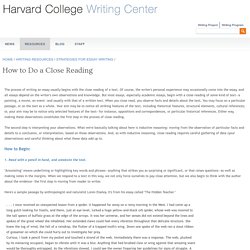
Of course, the writer's personal experience may occasionally come into the essay, and all essays depend on the writer's own observations and knowledge. But most essays, especially academic essays, begin with a close reading of some kind of text—a painting, a movie, an event—and usually with that of a written text. When you close read, you observe facts and details about the text. You may focus on a particular passage, or on the text as a whole. Your aim may be to notice all striking features of the text, including rhetorical features, structural elements, cultural references; or, your aim may be to notice only selected features of the text—for instance, oppositions and correspondences, or particular historical references. The second step is interpreting your observations. How to Begin: 1. Here's a sample passage by anthropologist and naturalist Loren Eiseley. 2. What do we notice in the previous passage? What is Close Reading? The common core standards are encouraging teachers to engage students in close reading.
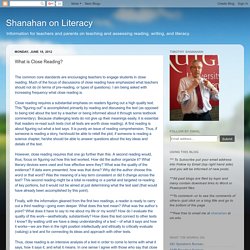
Much of the focus of discussions of close reading have emphasized what teachers should not do (in terms of pre-reading, or types of questions). I am being asked with increasing frequency what close reading is. Close reading requires a substantial emphasis on readers figuring out a high quality text. This "figuring out" is accomplished primarily by reading and discussing the text (as opposed to being told about the text by a teacher or being informed about it through some textbook commentary). Because challenging texts do not give up their meanings easily, it is essential that readers re-read such texts (not all texts are worth close reading). However, close reading requires that one go further than this.
Finally, with the information gleaned from the first two readings, a reader is ready to carry out a third reading—going even deeper. Close Reading of Literary Texts. Grades 6 – 8 | Lesson Plan | Standard Lesson What is Poetry?
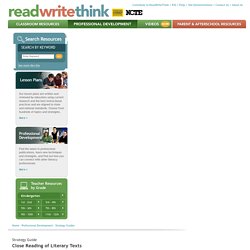
Contrasting Poetry and Prose Students often find poetry frustrating and meaningless. By helping students think critically about the differences between poetry and prose, this introduction sets the stage for different strategies for comprehending poetic texts. Grades 9 – 12 | Lesson Plan | Standard Lesson Reading Literature in Translation: Beowulf as a Case Study Using several translations of the same passage of Beowulf, this lesson introduces students to the idea that translation is not an objective practice, but that it involves "imaginative reconstruction. " How to do a Close Reading. Close Reading Strategies from ASCD.
The Art of Close Reading (Part One) To read well requires one to develop one’s thinking about reading and, as a result, to learn how to engage in the process of what we call close reading.
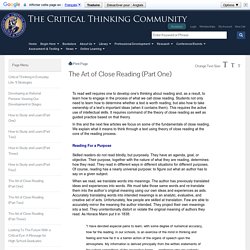
Students not only need to learn how to determine whether a text is worth reading, but also how to take ownership of a text’s important ideas (when it contains them). This requires the active use of intellectual skills. Close Reading. With our skill-based activity sheets and quizzes, Storyworks readers engage closely with articles.
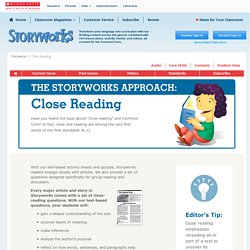
We also provide a set of questions designed specifically for group reading and discussion. Every major article and story in Storyworks comes with a set of close-reading questions. With our text-based questions, your students will: gain a deeper understanding of the textuncover layers of meaningmake inferencesanalyze the author’s purposereflect on how words, sentences, and paragraphs help build the larger workand more! You can find the close-reading questions (with answers) in your Teacher’s Guide. Or, download them from each article’s resources page as an activity to print or project (without answers). For fiction, we have a fantastic new appoach we call our “fiction kit.”